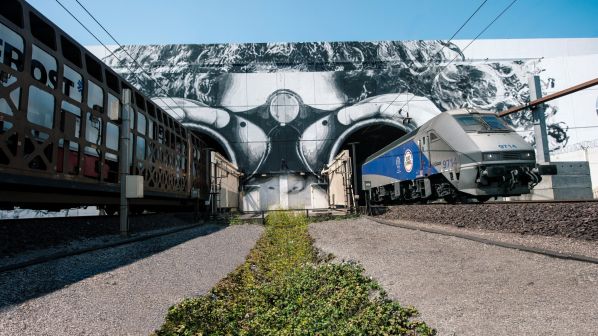AS Getlink prepares to celebrate the 30th anniversary of the opening of the Channel Tunnel on May 6 1994, the company has set itself the objective of doubling the number of high-speed services that operate between London and mainland Europe within the next 10 years.
At the same time, the company is calling on the British government to invest in providing the W12 loading gauge between the Channel Tunnel and London, with the aim of increasing the number of through freight trains handled by its subsidiary Eurotunnel from the current low level of only four a day.
Announcing on December 14 that the time required to bring new-high speed services to market had been reduced to five years, Getlink CEO, Mr Yann Leriche, contrasted this with the 10 years that it took to introduce Eurostar services to Amsterdam. Getlink subsidiary Eurotunnel completed market studies in 1999 but Eurostar did not launch its first train until 2018. “The time to market was too long,” Leriche said.
The size of the potential market was not the problem, he added, noting that the 1 million passengers carried in 2023 is only one-third of a potential market of 3 million passengers a year. Work to provide larger check-in and border control facilities at Amsterdam Central station, due to start in July 2024 and expected to take six months to complete, should enable Eurostar trains to carry their full complement of passengers.
According to Leriche, the time taken to get to market is so long that new services through the Channel Tunnel are not a viable proposition if the potential operator relies on private finance. “That is why we have no other operator,” he said, Eurostar having enjoyed a monopoly on high-speed traffic through the Channel Tunnel since it began operating from London to Paris and Brussels on November 14 1994.
The shorter time to market should encourage new operators, and make it simpler for Eurostar to introduce new routes as it aims to grow traffic to 30 million passengers a year at the merged Eurostar and Thalys businesses by 2030, from 19 million in 2019 before the Covid-19 pandemic. “Five years is viable,” said Leriche, before outlining how Getlink has achieved this by concentrating on four areas, the first being to identify new destinations by means of market research.
Getlink has also been working with the European Union Agency for Railways (ERA), the French rail safety regulator EPSF and its British counterpart the Office of Rail and Road (ORR) to revise standards applying to the Channel Tunnel so that a wider variety of high-speed rolling stock may operate through it. This could include more standardised and shorter trains than Eurostar’s original e300 trains with 18 passenger cars and the 16-car e320 supplied by Siemens.
According to Leriche, Getlink has also worked with rolling stock manufacturers to ensure that these revised standards are incorporated in their standard, interoperable products, enabling Channel Tunnel-specific safety requirements such as greater fire resistance to be added at “very minimal cost.”
“We can say to new entrants ‘the work has been done, and in five years you will be operating.’”
Mr Yann Leriche, Getlink CEO
Asked by IRJ if this meant that any TSI-compliant train could operate through the Channel Tunnel, Leriche replied “almost, not 100%.” He added that the trains ordered by aspiring new entrant Evolyn from Alstom would be to a standard design with additional fire protection.
The fourth strand of work to cut time to market has seen Getlink preparing the ground for new services by working with infrastructure managers Infrabel, Swiss Federal Railways (SBB), DB Network, SNCF Network and HS1 Ltd in Britain on securing train paths and providing the secure check-in facilities that will be needed at stations. Insufficient terminal capacity caused in part by the additional time required to pass through passport control after Brexit has been a constraint for Eurostar in London and Amsterdam in particular, preventing it from selling all available seats on some trains.
Asked if sufficient capacity would be available to accommodate new entrants at the London terminus, Leriche answered “the space will be found at St Pancras through a new entrance. There is space, there is potential,” he said, adding that Getlink was working very closely with station operator HS1 Ltd. “We can say to new entrants ‘the work has been done, and in five years you will be operating.’”

Getlink’s development work has concluded that a journey time of 4 hours or less is required to shift 50% or more of airline traffic to greener, high-speed rail. Amongst the potential new routes, development is most advanced on London - Cologne - Frankfurt, where potential paths and station options have been identified. The total airline market here is 4 million passengers a year, and with a journey time of 4 hours to Cologne and 5 hours to Frankfurt, Getlink believes that a high-speed service of four to six trains a day in both directions could attract 2 million passengers a year. This would capture 40% of the air-rail market and deliver what Leriche described as a “phenomenal” 97% reduction in CO2 emissions per passenger. “The demand is there,” he said.
Development is less advanced for a London - Geneva service where airline traffic is 2.5 million passengers a year. With a journey time of 5h 30min and two to three return services a day, high-speed rail would achieve a 30% market share, carrying 1 million passengers a year and cutting CO2 emissions per passenger by 95%. Getlink is also assessing potential routes from London to Basel and Zurich, to Bordeaux, and to Lyon and Marseille, where it has completed market surveys but has yet to finish work on paths and stations.
To support new routes, which according to one Getlink insider would cost a new entrant €1bn to launch, Leriche also announced that Getlink would be making a total of €50m available from 2025 to 2030 under the Eurotunnel Incentive for Capacity Additions (ETICA) programme. This is intended to help meet start-up costs for activities such as marketing and communications while traffic builds up. ETICA provided Eurostar with €9m for its London - Amsterdam service in 2023, and support is due to rise to €23m in 2030, according to Getlink.
W12 to London
As it looks to make the fullest use of existing capacity through the Channel Tunnel, Getlink is also aiming to increase the number of freight trains operating between Britain and mainland Europe. It points out that an average of four trains a day used the Channel Tunnel in 2023, carrying 1 million tonnes of freight and well below the maximum annual capacity of 8.1 million tonnes. According to Leriche, the main reason is the lack of the W12 loading gauge on Network Rail (NR) infrastructure between Dollands Moor in Kent and Wembley in north London, which would enable swapbodies and 9ft 6in-high containers to be carried on conventional intermodal wagons, obviating the need for expensive specialist rolling stock with a lower deck height such as the Megafret wagon.
Leriche said that moving intermodal consignments by rail from Europe to destinations beyond London was “not financially attractive” at present, due to the need for specialist rolling stock or transhipping consignments upon arrival in Britain. Demand was not being met by the few freight paths available on High Speed 1, the high-speed line from the Channel Tunnel to London, which was built to the more generous GC loading gauge but only as far as Barking in the eastern suburbs of London as far as intermodal freight is concerned.
According to an economic viability study produced for Eurotunnel by Volterra in December 2022, W12 could be provided on the route from Dollands Moor to Wembley via Maidstone East for £41.63m, which Leriche described as “an entirely reasonable cost.” Getlink is now calling for the British government to fund this project with some of the money it has saved by cancelling Phase 2 of High Speed 2 (HS2), pointing to potential benefits that include reducing congestion on the M20 motorway in Kent, reducing carbon emissions and improving the resilience of cross-Channel transport.
Connecting the Channel Tunnel with W12-cleared West Coast Main Line (WCML) at Wembley would enable trains from Europe to reach intermodal terminals serving major centres of production and consumption in the Midlands, north of England and Scotland, providing better access to the European market and strengthening supply chains between Britain and the European Union.
“We are asking the British authorities to provide W12,” Leriche said. “It should be put on the priority list.”

